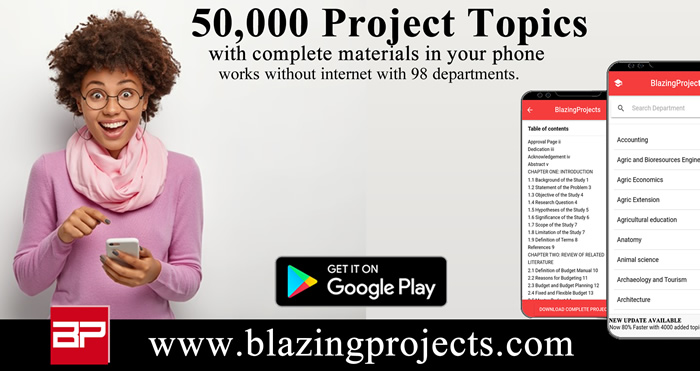THE IMPACT OF INFORMATION COMMUNICATION TECHNOLOGY ON NIGERIA’S PUBLIC ACADEMIC LIBRARIES
( A CASE STUDY OF THE UNIVERSITY UYO).
CHAPTER ONE INTRODUCTION With the invention of Information and Communication Technology, libraries now use various types of technologies to aid the services they render. Everyday new technological advances affect the way information is handled in libraries and information centers. The impacts of new technologies are felt by libraries in every aspect. Computing technology, communication technology and mass storage technology are some of the areas of continuous development that reshape the way that libraries access, retrieve, store, manipulate and disseminate information to users. The academic library has been from its inception an integral part of institutions of higher learning, rather than an appendix or adjunct. Oyedun (2007) defines academic libraries as those libraries that are mainly found in tertiary institutions, they are established to support learning, teaching and research processes. Over the past twenty seven years, academic libraries have been affected by changes in information and communication technology. The rate of changes is still accelerating in this area. The introduction of various information technology (ICT) trends has lead to reorganization, change in work patterns, and demand for new skills, job retraining and reclassification positions. Technological advancement of the past twenty five years, such as the electronic database, online services, CD-ROMs and introduction of internet has radically transformed access to information. Rana (2009) opines that ICT holds the key to the success of modernizing information services. Applications of ICT are numerous but mainly it is used in converting the existing paper-print records in the entire process of storage, retrieval and dissemination. ICT has impacted on every sphere of academic library activity especially in the form of the library collection development strategies, library building and consortia. ICT presents an opportunity to provide value-added information services and access to a wide variety of digital based information resources to their clients. Furthermore, academic libraries are also using modern ICTs to automate their core functions, implement efficient and effective library cooperation and resource sharing networks, implement management information systems, develop institutional repositories of digital local contents, and digital libraries: and initiate ICT based capacity building programmes for library users. Information and Communication Technology (ICT) has brought unprecedented changes and transformation to academic library and information services, conventional LIS such as OPAC, users services, reference services, bibliographic services, current awareness services, Document delivery, interlibrary loan, Audio visual services and customer relations can be provided more efficiently and effectively using ICT, as they offer convenient time, place, cost effectiveness, faster and most-up-to-date dissemination and end users involvement in the library and information services process. The impact of ICT characterized on information services by changes in format, contents and method of production and contents and method of production and delivery of information products. Emergence of internet as the largest repository of information and knowledge, changed role of library and information science professionals from intermediary to facilitator, new tools for dissemination of information and shift from physical to virtual services environment and extinction of some conventional information services and emergence of new and innovational web based.
GET THE COMPLETE PROJECT»
Do you need help? Talk to us right now: (+234) 8111770269, 08111770269 (Call/WhatsApp). Email: [email protected]
IF YOU CAN’T FIND YOUR TOPIC, CLICK HERE TO HIRE A WRITER»
Disclaimer: This PDF Material Content is Developed by the copyright owner to Serve as a RESEARCH GUIDE for Students to Conduct Academic Research. You are allowed to use the original PDF Research Material Guide you will receive in the following ways: 1. As a source for additional understanding of the project topic. 2. As a source for ideas for you own academic research work (if properly referenced). 3. For PROPER paraphrasing ( see your school definition of plagiarism and acceptable paraphrase). 4. Direct citing ( if referenced properly). Thank you so much for your respect for the authors copyright. Do you need help? Talk to us right now: (+234) 8111770269, 08111770269 (Call/WhatsApp). Email: [email protected]
Related Current Research Articles
Purchase Detail
Hello, we’re glad you stopped by, you can download the complete project materials to this project with Abstract, Chapters 1 – 5, References and Appendix (Questionaire, Charts, etc) for N4000 ($15) only, To pay with Paypal, Bitcoin or Ethereum; please click here to chat us up via Whatsapp.
You can also call 08111770269 or +2348059541956 to place an order or use the whatsapp button below to chat us up.
Bank details are stated below.
Bank: UBA
Account No: 1021412898
Account Name: Starnet Innovations Limited
The Blazingprojects Mobile App

Download and install the Blazingprojects Mobile App from Google Play to enjoy over 50,000 project topics and materials from 73 departments, completely offline (no internet needed) with the project topics updated Monthly, click here to install.
Recent Comments